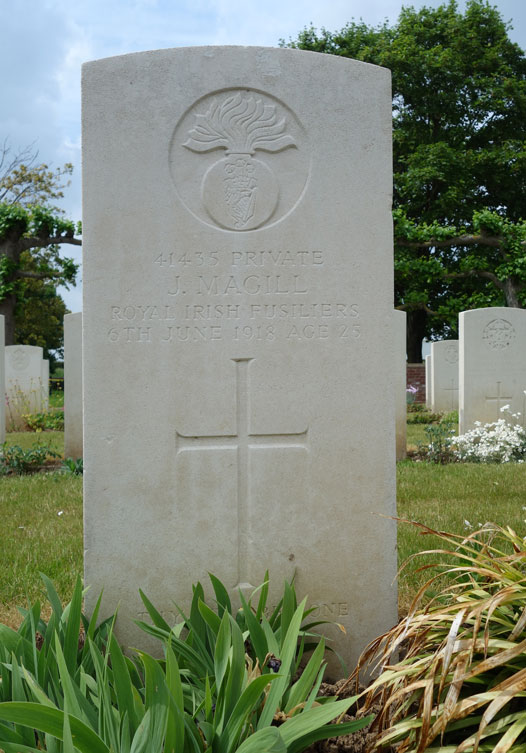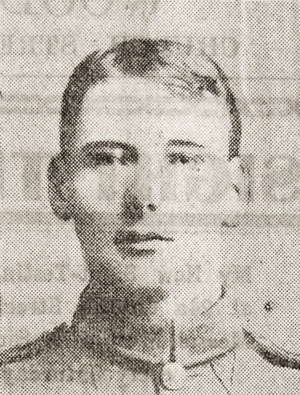![]() In memoriam
In memoriam ![]()
Private James Magill

James Magill was born on 5 April 1893 at Springwell Street, Ballymena, the first of fifteen children of dealer and green-grocer Dyas Magill and his wife Catherine (nee Dunlop). By 1911 he was living with his family at Springwell Street and working as a pork cutter's assistant. He was later employed as a railway labourer.
Magill enlisted in the North Irish Horse at Antrim on 8 November 1915 (No.1805). He embarked for France on 29 June 1916, joining A Squadron in the field at Pas three weeks later. A Squadron was then part of the 1st North Irish Horse Regiment, serving as corps cavalry to VII Corps.
In September 1917 the 2nd North Irish Horse Regiment was dismounted and most of its men, together with some from the 1st Regiment, were transferred to the infantry. After training at the 36th (Ulster) Division Infantry Base Depot at Harfleur, the men were formally transferred to the Royal Irish Fusiliers on 20 September and soon after were posted to the 9th (Service) Battalion – re-named the 9th (North Irish Horse) Battalion – joining it in the field at Ruyaulcourt. Magill was issued regimental number 41435 and posted to C Company.
Magill saw action with the battalion in the Battle of Cambrai in November and December 1917. On 16 December, following severe trench fighting south of Marcoing, he was hospitalised suffering from shell-shock. However he returned to his battalion two weeks later. A concerned friend of his mother had written to the authorities:
Please let me know if you have any information of No.41435. Private James Magill (formerly in Nth Irish Horse) now in C. Coy. 9th Battn Ryl. Irish Fusiliers Brit. Expedty. Force. as his Mother here is very anxious to hear. She has had no letter from him since 19th Novbr./17 & has just heard fm. a niece in Belfast who had written him lately that the letter had been returned to her.
Magill was with his battalion during the retreat from St Quentin from 21 to 28 March 1918 during the German spring offensive. Like many of the regiment he was posted as missing. In fact he had been captured near Nesle, probably following the fighting at Erches, on 27 March.
In June he was being held at a prisoner of war camp at Ham, south-west of St Quentin. On the night of 5/6th a bomb was dropped on the camp by a French airship. More than twenty British prisoners were killed, including Private Magill. He and the other victims of the bombing were buried nearby in the German cemetery (Map reference 66d.Q.2.a.1.4).
It was some time before Magill's family were certain of his fate. Weeks after he was killed his mother received a much-delayed postcard from him reassuring her that he was well. She passed it on to military authorities. In November 1918 the Red Cross confirmed the fact and circumstances of his death, but former POWs returning to Ballymena cast doubt on this. In December the Ballymena Weekly Telegraph reported:
Mrs. Magill, Springwell Street, Ballymena, has been notified that her son, Private James Magill, Royal Irish Fusiliers, who was taken prisoner in March last, was killed at Ham during an air raid carried out by the French in the month of June. The information comes from the International Red Cross Society at Geneva. About eight weeks after he was supposed to have been killed his mother received two postcards from him stating that he was a prisoner and "sound," and other men who were with him as prisoners and have since been released and have returned to Ballymena state that they saw all the victims of the air raid referred to, and that he was not amongst them. As there is consequently much doubt as to his fate any information from released soldiers who were with him at Ham will be gladly received by his mother. He enlisted originally in the North Irish Horse.
Following further inquiries the Red Cross confirmed their earlier advice in May 1919.
Later that year the bodies of the British soldiers buried in the German cemetery at Ham were exhumed and reburied in a new cemetery. Magill's body was identified by his paybook and identity disc. He is buried at Ham British Cemetery, Muille-Villette, Somme, France, grave II.E.27. The grave inscription reads:
41435 PRIVATE
J. MAGILL
ROYAL IRISH FUSILIERS
6TH JUNE 1918 AGE 25
THY WILL BE DONE

Gravestone image Copyright © Phillip Tardif with all rights reserved as set out in this Use of Material policy. Image from the Ballymena Weekly Telegraph of December 1918 kindly provided by Nigel Henderson, Researcher at History Hub Ulster (www.greatwarbelfastclippings.com).

